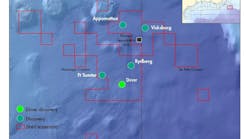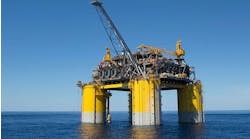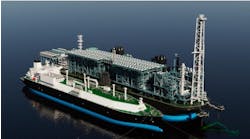Intrusive traps form from "hazardous" zones
Andrew Hurst
Joe Cartwright
Mads Huuse
Davide Duranti
Injected Sand Research Group,
Universities of Aberdeen & Cardiff
As an exploration play, sand injectites remain lightly explored and poorly understood. The Northwest European continental margin (NWECM) provides the most extensive documentation and broadest recognition of sand injectites. Despite this, many operators retain a conservative view of sand injectites in exploration and field development. Operators often do not consider them enhancers of field-wide vertical permeability, and in several basins, avoid possible sand injectites as potential drilling hazards.
The availability of basin-wide merged 3D seismic volumes and abundant borehole data (often with extensive core) makes the NWECM a workbench for new exploration targets. This includes documentation and testing of new trapping styles such as sand injectites.
null
Large areas of the NWECMexhibit intrusive traps, and while geologists have identified several, exploration wells have tested several. In many cases, sand injectites are along and adjacent to the crestal areas of thick, turbiditic sand bodies (e.g. the Forties and Heimdal formations). Elsewhere, for example the US Gulf Coast, operators to consider sand injectites - we are quite sure that they are there.
Sand injectites form distinct drilling targets most commonly, but not exclusively, in association with deepwater clastic reservoirs where they attach to depositional bodies or form discrete reservoir bodies in their own right.
null
Bright, discordant seismic reflections indicate sand injectites encased in mudstones. This seismic character may be either soft or hard depending on the pore fluid and degree of cementation. Operators have underestimated sand injectites’ significance on reservoir volume and recovery.
A range of basin-scale processes leads to the formation of intrusive traps. Hence, explorers can conceptualize a broad range of new play types. The generation of overpressure during burial is an underlying driver behind intrusive trap formation. Typically, sand injection occurs before strata are buried more than 500 m deep; some injectites are generated within a few meters of the seafloor.
During the early to mid-1990s, numerous North Sea operators recorded sand injectites as reservoirs. Operators encountered unusual sedimentary facies with crosscutting geometries in cores in several deepwater clastic reservoirs. Interpreters also recognized steep-sided mounds on seismic data.
The difficulty in predicting the stratigraphic location (biozone) of reservoir units and the poor imaging of key surfaces, such as top reservoir, complicate reservoir development. As 3D seismic data continues to improve, interpreters identify more sand injectites and recognize the structures’ exploration potential as well as their effect on reserve distribution in depositional reservoirs.
null
Deepwater occurrence
Sand injectites occur throughout the stratigraphic record and are most commonly associated with deepwater depositional environments in petroleum basins. Operators often identify sand injectites in Paleogene and Neogene strata.
Intrusive traps are distinct from structural or stratigraphic traps and lie within and crosscut several biostratigraphic zones. They have sharp lithological boundaries and form reservoirs of Darcy-range permeability with excellent vertical and lateral connectivity, even when the sand content is low (net/gross < 10%).
One highlight of 2004 is the exploration of a sand injectite complex offshore Norway in the Marathon/Lundin well 24/9-7. The successful North Sea well discovered a >100 m oil column in high-quality reservoir and provides an interesting case study.
Well 24/9-7 drilled the Hamsun prospect that seismic interpretation identified at least 10 years ago. Previously, two wells discovered thin oil legs downdip of the main feature. Other exploration companies reasoned that the feature was too small, unlikely to contain good reservoir, most likely held gas (if hydrocarbons were present), and was too risky. All these caveats were for a prospect at less than 2,000 m subsea. Drilling proved all this reasoning incorrect.
Seismic limits
Crosscutting features imaged on seismic may be challenging enough for explorationists to conceptualize as prospects, but there are also limits to what seismic data can reveal. Interpreters miss many injectites on seismic data because conventional data does not detect dikes that dip in the range of 50-60° unless the dikes are thick (probably around 10 m, >5 m thick at ~2 km burial, and thicker at greater depth). Long offset acquisition can compensate for this, but at inclinations greater than 60° dip imaging remains poor.
For field development where sand injectites are significant, there are at least three important issues to address:
null
•Specific well targets: Injected sand reservoirs, known since the mid-1990s, produce at high rates (Harding fields, BP, UK). Operators could not target specific injectites until they could seismically image the geometry of injected sands. Pioneering work on Alba field (Chevron, UK), including acquisition and interpretation of 3D converted-wave (PS) seismic data, demonstrated the significance of injected sand bodies associated with turbidite reservoirs as targets for high-rate development wells. Elsewhere, operators obtained similar results (i.e. Gryphon, Kerr McGee, UK). Operators found critical acoustic impedance displays derived from P- or PS-wave data when defining sand injectite reservoir quality and distribution.
•Enhancement of vertical reservoir connectivity: Dikes cutting through low permeability depositional units (mudstones, shales, debrites) link depositional units and enhance vertical permeability. Failure to recognize the potential role of injectites can cause underestimation of recovery efficiency, timing, and the rate of water ingress.
•Reservoir geometry: Geologists can make erroneous models of reservoir architecture and geometry if they misidentify of sand injectite facies as debrite or slump facies. The lateral extent, position within the overall stratigraphy, and vertical permeability of reservoir models are sensitive to identifying and including injectites.
Recognizing injectites
Dogma is the main barrier operators face in recognizing the significance of sand injectites. As operators record sand injectites, usually dikes, in deepwater reservoir facies, the main exploration and reservoir characterization problem is: How important are they? There are geological traditions that associate upward injection of sand with sudden sedimentary loading from above (e.g. collapse of slope sediments as a slide or slump onto sands in a more basinal location) or link injection with active faulting. Thorough examination of seismic and borehole data reveals evidence of volumetrically larger injected bodies of sand (possibly >4 x 107 cu m) than could ever form by loading and that are not associated with major faults. It is equally important to recognize that sand injection may be multi-phase, which increases the volume of sand involved.
Our own studies of deepwater clastic reservoirs, which include reservoirs from West Africa, the Mediterranean, and the NWECM, demonstrate the limitations of previous geological models. The deliberate avoidance of sand injectites (at the time not recognized as such) for drilling safety reasons caused an undersampling of injected sand reservoirs in the North Sea and other areas where they are abundant and where they have subsequently become an active exploration play. Similar situations likely exist elsewhere.
The global search for sand injectites in deepwater clastic reservoir plays seems appropriate both for generating new exploration targets and for evaluating recovery factors. On-going research focuses on improving the geological and geophysical characteristics of sand injectites on a global basis to alleviate exploration risk, generate new drilling opportunities, and enhance recovery.







